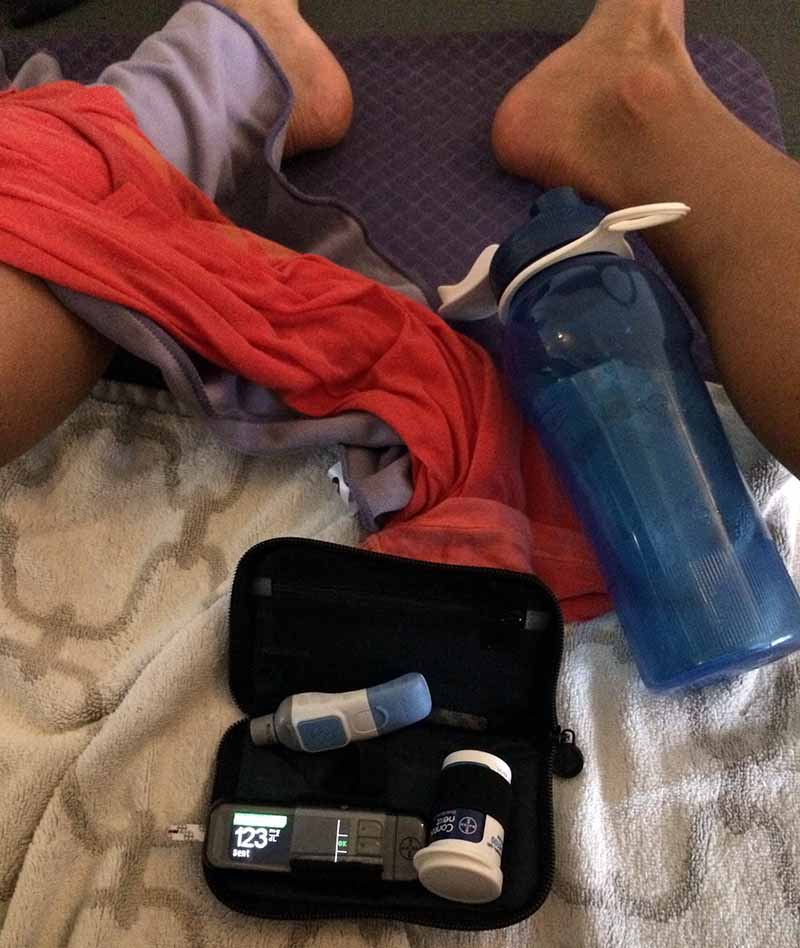I try to include yoga in my workout schedule whenever I can. It will never be my main type of workout (I love resistance training too much for that), but it’s a great addition to my normal routine.
Because I don’t do yoga that often, it’s taken me a little longer to figure out how to manage my blood sugar when on the yoga mat, especially because different types of yoga will affect my blood sugar in different ways.
Some yoga practices have you move through the poses super fast (making it almost a cardio workout) while others focus more on strength or meditation.
I’ve primarily taken Vinyasa and Bikram yoga classes so I’ll focus on how they impact my blood sugar and what strategies I implement to stay in my preferred blood sugar range.

Why yoga is great for people living with diabetes
What I like about yoga is that you spend 60-90 minutes focusing on your breathing, stretching, and, in the case of Bikram yoga, sweating.
The benefits of yoga are plentiful, and I have several friends within the diabetes community who practice yoga on a regular basis and they look and feel great.
The primary benefits of yoga that lured me in were the increased flexibility (something I need to continue working on) and the sense of relaxation afterward.
It can also help with reducing stress, thereby lowering cortisol levels, which is great for blood sugar management.
A further benefit of yoga is that you learn breathing and relaxation methods that can use every time life gets overwhelming.
How Vinyasa Yoga affects my blood sugar
Vinyasa yoga is the type of yoga you are most likely to encounter in mainstream gyms in the US. It’s typically a fairly quick flow of poses accompanied by coordinated breathing.
How inspiring the practice is and how it will affect blood sugars depend a lot on the instructor. Because Vinyasa doesn’t have a standardized set of poses, no two classes are ever alike. Vinyasa can be everything from a relaxing flow of poses all the way up to “power yoga” that will push your strength and endurance to the limit.
I’ve been in a few classes where the flow was very fast, making the blood sugar impact similar to what I’d expect from a cardio session, but most often, it’s a more slow-paced flow that only has a minor impact on my blood sugars.
So, if I know the type of flow the instructor is teaching, I’ll adjust my meal insulin bolus prior to the practice accordingly:
- If I expect it to be a fast-paced yoga flow (or don’t know what to expect), I’ll do a 25-30% bolus reduction with my last meal before the practice
- If I expect a slower flow, I’ll do a 0-20% reduction.
Of course, the exact reduction depends on what my blood sugar is before the workout. If it’s higher than want it to be, I will reduce my bolus less than normal.
I haven’t found that any post-yoga reductions in bolus or basal insulin is necessary. Yoga doesn’t affect my blood sugar for hours afterward like resistance training does.
How Bikram Yoga affects my blood sugar
Bikram yoga is different from Vinyasa since it’s a 90-minute class and takes you through the 26 different Bikram poses in a heated room.
I rather like the heated room (I tend to get cold very easily), but it can make blood sugar management harder because I can’t rely on the senses I usually rely on to tell me whether my blood sugar is running low.
The heat in the room makes me sweat and elevates my heart rate, which are my two main indicators of low blood sugar. Because of that, I am not sure I would feel it if my blood sugar was dropping during a Bikram yoga class. So for Bikram yoga, I’ll rely heavily on my CGM (Continuous Glucose Monitor).
The first time I tried Bikram yoga, I wasn’t wearing a CGM so I manually tested my blood sugars before we got started, after an hour, and then again after class. To my surprise, my sugars were…..perfectly stable (!). When class started, my blood sugar was 116 mg/dL (6.4 mmol/L) and after 90 minutes, it was 123 mg/dL (6.8 mmol/L). This was with a 20% bolus reduction before the class.
I had expected a larger impact on my blood sugar because of the heat and because the class was 90 minutes, but I have taken several other Bikram classes now and the result has always been the same.
Apparently, the Bikram classes I take simply don’t affect my blood sugar very much so, I’ve stuck with a ~20% bolus reduction for this type of yoga.

Conclusion
I enjoy both types of yoga, although I find Vinyasa a little more accessible. Vinyasa is usually only an hour or less and although your heart rate gets up, you don’t feel like you’ve taken a bath with your clothes on afterward.
Both types of yoga leave me feeling relaxed and in a good mood.
As with any other type of exercise, it’s important that you find your personal formula for food and insulin around your yoga classes (in collaboration with your medical team if needed).
I have found that yoga has a minimal effect on my blood sugar and that I only need a small (or no) reduction to my pre-yoga bolus, but it may be different for you.




Virginia
I take classes at a yoga studio, not a gym or fitness center, I hit the mat 3-4x per week. Most of the classes I attend are Ashtanga, primary series, 60 or 90 minutes. I occasionally take a Vinyasa class, or a Restorative/Iyengar style class. I’ve also taken specialty classes, like Intro to Wall (inversions, etc. using a wall with bands). Ashtanga is very vigorous and the room usually becomes pretty warm and humid. Usually my blood sugar goes up, but it has gone down a time or two. There are so many styles and types of yoga in the US. If you go and don’t like it, try a different style and instructor.
Heather
?my sugar runs high most of the time. Just had first ever yoga class. Almost vomited and felt light headed. Tested when I got home ( 3 hours after ) sugar wAs high . Frightening but I’m going back!
Christel Oerum
Sounds like a hardcore yoga class! Keep a record of your BGs and look for patterns. It might have been a one-off, but if not you might need a correction before or after
Wilson Kumar
Yoga mean effort less static movement of body which produced the highest level of relaxation and peace within thereafter beta cell growth will become positive to respond your body it’s very complex mechanism.
Brett Taylors
Hi I’m a yoga enthusiast and also a football player with a high sugar level, most of the time. I love how you helps the community and share the awareness of diabetes by simply sharing these kinds of exercise and its effects, keep doing it, kudos!
Christel Oerum
Thank you, Brett! Really appreciate you taking the time to write that note
Sheryl Bergstrom
Such an amazing blog, I’ve been diagnose to have type 2 diabetes a year ago and i was really depressed about that. But i realize its my wrong doing too, since we dont have history of that. I had join then on Hatha Yoga and i just love it. And it improves my overall wellness and physical fitness.
Paula
I recently bought a book on Arthritis and Yoga. Sometimes with my foot problems, floor exercises are the best option for me. So, yoga or pilates type exercises are my only options at times. For me, Yoga is extremely helpful to get me able to move because of the beneficial effects to arthritic changes throughout my body. The book helped me understand what yoga does for the joints of the body. It helps restore those joints and replenish what we need in our joints to keep moving without pain.
I’ve seen glimpses of the effects you mention with weights, although I have only a small experience with resistance training. (A Body Pump class for several months some years back and some use of small weights in my home). I look forward to watching some of your workout videos in the future. I got a new computer that I can use in my workout room…….
ferry
thank you for sharing nice post.
Julir
Thank u for sharing i ve been a diabetic over a decade lots of complications i need help i want to get help diagnosed at 13 now 30 but no parent guidenesss always feeling sick tired i eat ok but i want go do bettsr6 now!!!!!!
Look up to u
Dorothy
Cool post. Personally, I’ve noticed that doing 45 min or more of medium+ intensity yoga can drop me a LOT–I use Humalog with a pump, and I suspect that poses where I’m working the muscle under where my set is might make the insulin get absorbed faster than I’m used to. Anybody else had this happen?
Thea
Hi Dorothy,
I have the same effect as you. I normally pause my basal while I’m in yoga and it will stay stable during the course. Or I have tried eat bread an hour before yoga with no bolus and an hour yoga just took care of that rise in glucose for me. I have been loving yoga for this reason and researching more on the effect.
Erika
Great post! I’ve heard a lot of great things about bikram yoga, but haven’t worked up the guts to try it myself!
Amina
What a great post! Who would have through Bimran Yoga would do that to your BG. I’ve always been afraid that it would drag my sugar way down. I must give it a try and see what effect it has on me. Thanks for sharing Christel xx